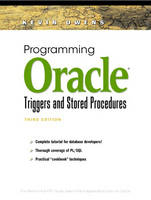
Programming Oracle Triggers and Stored Procedures
Prentice Hall (Verlag)
978-0-13-085033-1 (ISBN)
- Titel ist leider vergriffen;
keine Neuauflage - Artikel merken
Advanced Oracle features such as triggers and stored procedures make itpossible to build databases that incorporate business rules - allowing companiesto reengineer processes more quickly and effectively than ever. This is the"bible" for anyone designing complex Oracle databases that incorporatebusiness rules, and it is fully compliant with Oracle 10g. The book presents asimple methodology which yields a highly-maintainable repository of triggersand stored procedures which are easy to manage and modify as the businesschanges. Topics covered include: declarative constraints; analyzing constraintsthrough the data dictionary; PL/SQL program units; embedded SQL; datatypes and composite structures; error handling and exceptions; andinterprocess communication.A trigger is a condition, which if true, causes a stored procedure to execute.Stored procedures are SQL code embedded in the database that providescritical information to the end user when triggered.
KEVIN OWENS is the Oracle database administrator at the U.S. Department of the Treasury in Washington, DC.
Preface.
1. An Introduction to Relational Database Tables.
Before Relational Tables. SQL. Tables. SQL Statements. Table Column Datatypes. Behind Tables.
2. Interacting with Oracle.
Simplify SQL*Plus for Yourself on Windows. Connecting. Connecting to an Infrastructure. Disconnecting. Command Line. Changes on the Command Line. Scripts. Script Output. Command Line Arguments. SQL*Plus with Korn Shell. Batch Command Files. SQL*Plus with Active State Perl. Privileges. DUAL. Autotrace.
3. Declarative Constraints.
Primary Key. Unique. Foreign Key. Check. Not Null Constraints. Default Values. Modifying Constraints. Exception Handling. Data Loads.
4. A Data Model with Constraints.
Entity Relationship Diagram. Table Descriptions. DDL. Sample Data.
5. Viewing Constraints in the Data Dictionary.
What You Can See. Dictionary Views: An Overview. Constraint Views. USER_CONS_COLUMNS. USER_CONSTRAINTS. Data Dictionary Constraint Scripts.
6. Row Trigger Mechanics.
Introduction. Before versus After. Insert Row Trigger Syntax. Trigger Body. Example Row Triggers. A Table with Oracle Constraints and Business Rules.
7. Statement Level Triggers.
Sequence of Events. Insert Statement Trigger Syntax. Statement Level Aggregation. Processing Row Captured Data.
8. Complex Rule Enforcement.
9. The PL/SQL Environment.
A Hello World Program. Referencing Oracle Packages. USER_OBJECTS. Dependencies among Procedures. USER_DEPENDENCIES. USER_SOURCE. Sharing Code. Compilation Dependency. USER_ERRORS.
10. PL/SQL Program Units.
Procedures. Functions. Subprogram Encapsulation: Introduction to Packages. Package Specification. Package Body. Application Partitioning. Data Abstraction. Parameters and Modes. Overloading.
11. PL/SQL Language Features.
Comments. Assignments and Statements. Boolean Expression. Expressions with Null. Logical Operators. String Concatenation. Arithmetic Expressions. Variable Declarations. Types. IF Statement. CASE Statement. LOOP. STRING Manipulation Functions. Miscellaneous String Functions. Numeric Functions. Random Number Generation. Date Functions. Exceptions. Database Access with SQL. Sending Pipe Messages (DBMS_PIPE). Signaling Events with Alerts (DBMS_ALERT). Email Notification with Triggers and Alerts.
Index.
| Erscheint lt. Verlag | 17.12.2003 |
|---|---|
| Verlagsort | Upper Saddle River |
| Sprache | englisch |
| Maße | 150 x 250 mm |
| Gewicht | 785 g |
| Themenwelt | Informatik ► Datenbanken ► Oracle |
| ISBN-10 | 0-13-085033-0 / 0130850330 |
| ISBN-13 | 978-0-13-085033-1 / 9780130850331 |
| Zustand | Neuware |
| Informationen gemäß Produktsicherheitsverordnung (GPSR) | |
| Haben Sie eine Frage zum Produkt? |
aus dem Bereich

